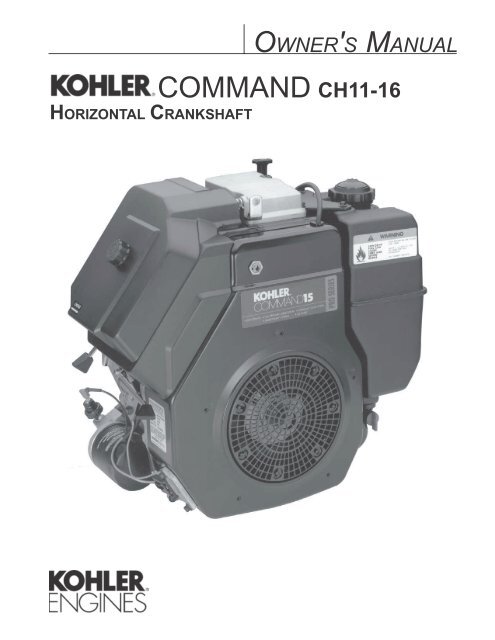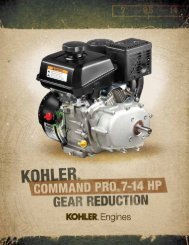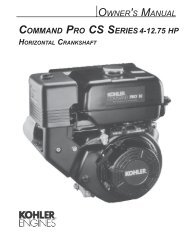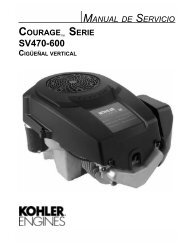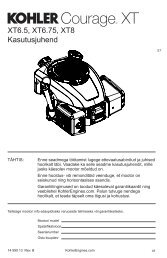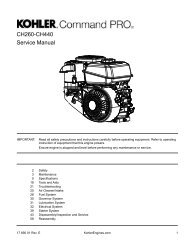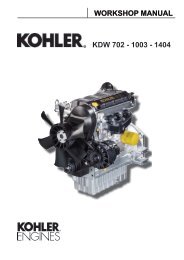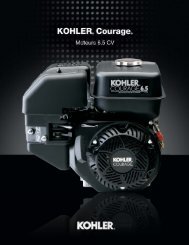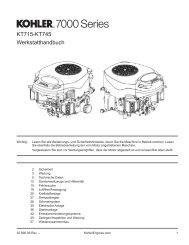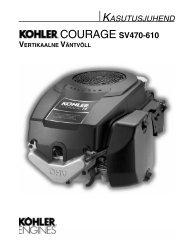English - Kohler Engines
English - Kohler Engines
English - Kohler Engines
Create successful ePaper yourself
Turn your PDF publications into a flip-book with our unique Google optimized e-Paper software.
OWNER'S MANUALCOMMAND CH11-16HORIZONTAL CRANKSHAFT1
Safety PrecautionsTo ensure safe operations please read the following statements and understand their meaning.Also refer to your equipment owner's manual for other important safety information. This manualcontains safety precautions which are explained below. Please read carefully.WARNINGWarning is used to indicate the presence of a hazard that can cause severe personal injury,death, or substantial property damage if the warning is ignored.CAUTIONCaution is used to indicate the presence of a hazard that will or can cause minor personal injuryor property damage if the caution is ignored.NOTENote is used to notify people of installation, operation, or maintenance information that isimportant but not hazard-related.For Your Safety!These precautions should be followed at all times. Failure to follow these precautions could resultin injury to yourself and others.WARNINGWARNINGWARNINGExplosive Fuel can cause fires andsevere burns.Do not fill the fuel tank while theengine is hot or running.Explosive Fuel!Gasoline is extremely flammableand its vapors can explode ifignited. Store gasoline only inapproved containers, in wellventilated, unoccupied buildings,away from sparks or flames. Do notfill the fuel tank while the engine ishot or running, since spilled fuelcould ignite if it comes in contactwith hot parts or sparks fromignition. Do not start the engine nearspilled fuel. Never use gasoline as acleaning agent.2Rotating Parts can cause severeinjury.Stay away while engine is inoperation.Rotating Parts!Keep hands, feet, hair, and clothingaway from all moving parts toprevent injury. Never operate theengine with covers, shrouds, orguards removed.CAUTIONElectrical Shock can cause injury.Do not touch wires while engine isrunning.Electrical Shock!Never touch electrical wires orcomponents while the engine isrunning. They can be sources ofelectrical shock.Hot Parts can cause severe burns.Do not touch engine while operatingor just after stopping.Hot Parts!Engine components can getextremely hot from operation. Toprevent severe burns, do not touchthese areas while the engine isrunning, or immediately after it isturned off. Never operate the enginewith heat shields or guardsremoved.CaliforniaProposition 65 WarningEngine exhaust from this productcontains chemicals known to theState of California to cause cancer,birth defects, or other reproductiveharm.
WARNINGSafety Precautions (Cont.)WARNINGWARNINGAccidental Starts can cause severeinjury or death.Disconnect and ground spark pluglead before servicing.Accidental Starts!Disabling engine. Accidentalstarting can cause severe injury ordeath. Before working on the engineor equipment, disable the engine asfollows: 1) Disconnect the sparkplug lead(s). 2) Disconnect negative(-) battery cable from battery.Carbon Monoxide can causesevere nausea, fainting or death.Avoid inhaling exhaust fumes, andnever run the engine in a closedbuilding or confined area.Lethal Exhaust Gases!Engine exhaust gases containpoisonous carbon monoxide.Carbon monoxide is odorless,colorless, and can cause death ifinhaled. Avoid inhaling exhaustfumes, and never run the engine ina closed building or confined area.Explosive Gas can cause fires andsevere acid burns.Charge battery only in a wellventilated area. Keep sources ofignition away.Explosive Gas!Batteries produce explosivehydrogen gas while being charged.To prevent a fire or explosion, chargebatteries only in well ventilatedareas. Keep sparks, open flames,and other sources of ignition awayfrom the battery at all times. Keepbatteries out of the reach of children.Remove all jewelry when servicingbatteries.Before disconnecting the negative (-)ground cable, make sure all switchesare OFF. If ON, a spark will occur atthe ground cable terminal whichcould cause an explosion if hydrogengas or gasoline vapors are present.Congratulations – You have selected a fine four-cycle, single cylinder, air-cooled engine. <strong>Kohler</strong> designs longlife strength and on-the-job durability into each engine…making a <strong>Kohler</strong> engine dependable…dependability youcan count on. Here are some reasons why:• Efficient overhead valve design and full pressure lubrication provide maximum power, torque, and reliabilityunder all operating conditions.• Dependable, maintenance free electronic ignition ensures fast, easy starts time after time.• <strong>Kohler</strong> engines are easy to service. All routine service areas (like the dipstick and oil fill, oil filter, air cleaner,spark plug, and carburetor) are easily and quickly accessible.• Parts subject to the most wear and tear (like the cylinder liner and camshaft) are made from precisionformulated cast iron. Because the cylinder liner can be rebored, these engines can last even longer.• Every <strong>Kohler</strong> engine is backed by a worldwide network of over 10,000 distributors and dealers. Servicesupport is just a phone call away. Call 1-800-544-2444 (U.S. & Canada) for Sales & Service assistance.To keep your engine in top operating condition, follow the maintenance procedures in this manual.3
Oil Fill/DipstickMufflerAir CleanerFuel TankChoke LeverElectric StarterOil Drain PlugOil Drain PlugOil Sentry (Optional)Oil FilterFuelShut-OffOil Drain PlugFigure 1. Typical Command Horizontal Shaft Engine.Throttle LeverRetractable StarterOil RecommendationsUsing the proper type and weight of oil in thecrankcase is extremely important. So is checking oildaily and changing oil regularly. Failure to use thecorrect oil, or using dirty oil, causes premature enginewear and failure.Oil TypeUse high quality detergent oil of API (AmericanPetroleum Institute) service class SG, SH, SJ orhigher. Select the viscosity based on the airtemperature at the time of operation as shown in thefollowing table.NOTE:Synthetic oils meeting the listed classificationsmay be used with oil changes performed atthe recommended intervals. However to allowpiston rings to properly seat, a new or rebuiltengine should be operated for at least 50hours using standard petroleum based oilbefore switching to synthetic oil.A logo or symbol on oil containers identifies the APIservice class and SAE viscosity grade. See Figure 3.***Figure 3. Oil Container Logo.*Use of synthetic oil having 5W-20 or 5W-30 rating is acceptable,up to 4°C (40°F).**Synthetic oils will provide better starting in extreme cold below23°C (-10°F).Figure 2. Viscosity Grades Table.Refer to “Maintenance Instructions” beginning onpage 8 for detailed oil check, oil change, and oilfilter change procedures.NOTE:Using other than service class SG, SH, SJ orhigher oil or extending oil change intervalslonger than recommended can cause enginedamage.4
Fuel RecommendationsWARNING: Explosive Fuel!Gasoline is extremely flammable and its vapors canexplode if ignited. Store gasoline only in approvedcontainers, in well ventilated, unoccupied buildings,away from sparks or flames. Do not fill the fuel tankwhile the engine is hot or running, since spilled fuelcould ignite if it comes in contact with hot parts orsparks from ignition. Do not start the engine nearspilled fuel. Never use gasoline as a cleaning agent.General RecommendationsPurchase gasoline in small quantities and store inclean, approved containers. A container with a capacityof 2 gallons or less with a pouring spout isrecommended. Such a container is easier to handleand helps eliminate spillage during refueling.Do not use gasoline left over from the previous season,to minimize gum deposits in your fuel system and toensure easy starting.Do not add oil to the gasoline.Do not overfill the fuel tank. Leave room for the fuel toexpand.Fuel TypeFor best results use only clean, fresh, unleadedgasoline with a pump sticker octane rating of 87 orhigher. In countries using the Research method, itshould be 90 octane minimum.Unleaded gasoline is recommended as it leaves lesscombustion chamber deposits. Leaded gasoline maybe used in areas where unleaded is not available andexhaust emissions are not regulated. Be awarehowever, that the cylinder head will require morefrequent service.Gasoline/Alcohol blendsGasohol (up to 10% ethyl alcohol, 90% unleadedgasoline by volume) is approved as a fuel for <strong>Kohler</strong>engines. Other gasoline/alcohol blends are notapproved.Gasoline/Ether blendsMethyl Tertiary Butyl Ether (MTBE) and unleadedgasoline blends (up to a maximum of 15% MTBE byvolume) are approved as a fuel for <strong>Kohler</strong> engines.Other gasoline/ether blends are not approved.Engine Identification NumbersWhen ordering parts, or in any communicationinvolving an engine, always give the Model,Specification, and Serial Numbers of the engine.The engine identification numbers appear on a decalaffixed to the engine shrouding. Include letter suffixes,if there are any.Record your engine identification numbers on theidentification label (Figure 4) for future reference.<strong>Engines</strong> without fuel tank.IMPORTANT ENGINE INFORMATIONTHIS ENGINE MEETS U.S. EPA AND CA 2005AND LATER AND EC STAGE II (SN:4) EMISSIONREGS FOR SI SMALL OFF–ROAD ENGINESFAMILYTYPE APPDISPL. (CC)MODEL NO.N11236SPEC. NO.SERIAL NO.BUILD DATEOEM PROD. NO.EMISSION COMPLIANCE PERIOD:EPA:CARB:CERTIFIED ON:REFER TO OWNER'S MANUAL FOR HP RATING,SAFETY, MAINTENANCE AND ADJUSTMENTS1-800-544-2444 www.kohlerengines.comKOHLER CO. KOHLER, WISCONSIN USA<strong>Engines</strong> with fuel tank supplied.IMPORTANT ENGINE INFORMATIONTHIS ENGINE MEETS U.S. EPA 2005, CA 2006 EXH/EVP AND EC STAGE II (SN:4) EMISSION REGS FORSI SMALL OFF–ROAD ENGINESFAMILYTYPE APPDISPL. (CC)MODEL NO.N11236SPEC. NO.SERIAL NO.BUILD DATEOEM PROD. NO.EMISSION COMPLIANCE PERIOD:EPA:CARB:CERTIFIED ON:REFER TO OWNER'S MANUAL FOR HP RATING,SAFETY, MAINTENANCE AND ADJUSTMENTS1-800-544-2444 www.kohlerengines.comKOHLER CO. KOHLER, WISCONSIN USAFigure 4. Engine Identification Label.The Emission Compliance Period referred to on theEmission Control or Air Index label indicates thenumber of operating hours for which the engine hasbeen shown to meet Federal and CARB emissionrequirements. The following table provides the EngineCompliance Period (in hours) associated with thecategory descriptor found on the certification label.5
Emission Compliance Period (Hours)EPACARBCategory C250 HoursModerate125 HoursCategory B500 HoursIntermediate250 HoursPre-Start Checklist• Check oil level. Add oil if low. Do not overfill.• Check fuel level. Add fuel if low.Category A1000 HoursExtended500 HoursRefer to certification label for engine displacement.Exhaust Emission Control System for modelsCH11,12.5,13,14,15,16 is EM.Operating InstructionsAlso read the operating instructions of the equipment this engine powers.ChokeOff — On• Check cooling air intake areas and externalsurfaces of engine. Make sure they are clean andunobstructed.• Check that the air cleaner components and allshrouds, equipment covers, and guards are inplace and securely fastened.• Check that any clutches or transmissions aredisengaged or placed in neutral. This is especiallyimportant on equipment with hydrostatic drive. Theshift lever must be exactly in neutral to preventresistance which could keep the engine fromstarting.WARNING: Lethal Exhaust Gases!Engine exhaust gases contain poisonous carbonmonoxide. Carbon monoxide is odorless, colorless,and can cause death if inhaled. Avoid inhaling exhaustfumes, and never run the engine in a closed building orconfined area.Cold Weather Starting Hints1. Be sure to use the proper oil for the temperatureexpected. See Figure 2 on page 4.2. Declutch all possible external loads.3. A warm battery has much more starting capacitythan a cold battery.4. Use fresh winter grade fuel. NOTE: Winter gradegasoline has higher volatility to improve starting.Do not use gasoline left over from summer.Starting1. For a Cold Engine – Place the throttle controlmidway between the “slow” and “fast” positions.Place the choke control into the “on” position.For a Warm Engine (normal operatingtemperatures) – Place the throttle/choke controlmidway between the “slow” and “fast”positions. Place the choke into the “on” position.See Figure 5.ThrottleFastOnFigure 5. Throttle and Choke Positions for StartingEngine.2. Start the engine as follows:For a Retractable Start Engine – SLOWLY pullthe starter handle until just past compression –STOP! Return starter handle, pull firmly with asmooth, steady motion to start. Pull the handlestraight out to avoid excessive rope wear from thestarter rope guide.Extend the starting rope periodically and check itscondition. If the rope is frayed, have it replacedimmediately by your <strong>Kohler</strong> Engine ServiceDealer.WARNING: Accidental Starts!Before extending and checking the retractable starterrope, remove the spark plug lead to prevent the enginefrom starting accidentally. Make sure the equipment isin neutral.For an Electric Start Engine – Activate thestarter switch. Release the switch as soon as theengine starts.NOTE:Do not crank the engine continuously formore than 10 seconds at a time. If theengine does not start, allow a 60 secondcool down period between startingattempts. Failure to follow theseguidelines can burn out the starter motor.6
NOTE:Upon start-up, a metallic ticking mayoccur. This is caused by hydraulic lifterleakdown during storage. Run the enginefor 5 minutes. The noise will normallycease in the first minute. If noisecontinues, run the engine at mid-throttlefor 20 minutes. If noise persists, take theengine to your local <strong>Kohler</strong> Service outlet.b. For engines equipped with a shutdownsolenoid: Position the throttle control somewherebetween half and full throttle; then stop the engine.BatteryA 12 volt battery is normally used. Refer to the operatinginstructions of the equipment this engine powers forspecific battery requirements.NOTE:If the engine develops sufficient speed todisengage the starter but does not keeprunning (a false start), engine rotationmust be allowed to come to a completestop before attempting to restart theengine. If the starter is engaged while theflywheel is rotating, the starter pinion andflywheel ring gear may clash, resulting indamage to the starter.If the starter does not turn the engine over, shutoff starter immediately. Do not make furtherattempts to start the engine until the condition iscorrected. Do not jump start using another battery(refer to “Battery”). See your <strong>Kohler</strong> EngineService Dealer for trouble analysis.3. For a Cold Engine – Gradually return the chokecontrol to the “off” position after the engine startsand warms ups.The engine/equipment may be operated duringthe warm up period, but it may be necessary toleave the choke partially on until the engine warmsup.4. For a Warm Engine – Return choke to “off”position as soon as engine starts.Stopping1. Remove the load by disengaging all PTOattachments.2a. For engines without a shutdown solenoid:Move the throttle to the ‘‘slow’’ or ‘‘low’’ idleposition. Allow the engine to run at idle for 30-60seconds; then stop the engine.If the battery charge is not sufficient to crank the engine,recharge the battery (see page 12).OperatingAngle of OperationThis engine will operate continuously at angles up to25°. Check oil level to assure crankcase oil level is atthe “F” mark.Refer to the operating instructions of the equipment thisengine powers. Because of equipment design orapplication, there may be more stringent restrictionsregarding the angle of operation.NOTE:Do not operate this engine continuously atangles exceeding 25° in any direction. Enginedamage could result from insufficientlubrication.CoolingNOTE: If debris builds up on the grass screen or othercooling air intake areas, stop the engineimmediately and clean. Operating the enginewith blocked or dirty air intake and coolingareas can cause extensive damage due tooverheating.WARNING: Hot Parts!Engine components can get extremely hot fromoperation. To prevent severe burns, do not touch theseareas while the engine is running–or immediately after itis turned off. Never operate the engine with heatshields or guards removed.Engine SpeedNOTE: Do not tamper with the governor setting toincrease the maximum engine speed.Overspeed is hazardous and will void theengine warranty.Maintenance InstructionsMaintenance, repair, or replacement of the emission control devices and systems, which are being doneat the customers expense, may be performed by any non-road engine repair establishment or individual.Warranty repairs must be performed by an authorized <strong>Kohler</strong> service outlet.WARNING: Accidental Starts!Disabling engine. Accidental starting can cause severe injury or death. Before working on the engine or equipment,disable the engine as follows: 1) Disconnect the spark plug lead(s). 2) Disconnect negative (-) battery cablefrom battery.7
Maintenance ScheduleThese required maintenance procedures should be performed at the frequency stated in the table. They should alsobe included as part of any seasonal tune-up.FrequencyDaily or BeforeStarting EngineEvery 25 HoursMaintenance Required• Fill fuel tank.• Check oil level.• Check air cleaner for dirty¹, loose, or damaged parts.• Check air intake and cooling areas, clean as necessary¹.• Service precleaner element¹.Every 50 Hours • Check gear reduction unit.Every 100 HoursEvery 200 HoursAnnually orEvery 500 Hours• Replace air cleaner element¹.• Change oil.• Remove cooling shrouds and clean cooling areas¹.• Change oil filter.• Check spark plug condition and gap.• Replace fuel filter.• Have bendix starter drive serviced².• Have solenoid shift starter disassembled and cleaned 2 .¹Perform these maintenance procedures more frequently under extremely dusty, dirty conditions.2Only required for Denso starters. Not necessary on Delco starters. Have a <strong>Kohler</strong> Engine Service Dealer performthis service.Check Oil LevelThe importance of checking and maintaining the properoil level in the crankcase cannot be overemphasized.Check oil BEFORE EACH USE as follows:1. Make sure the engine is stopped, level, and is coolso the oil has had time to drain into the sump.4. Remove the dipstick and check the oil level.The oil level should be up to, but not over, the “F”mark on the dipstick. See Figure 7.2. To keep dirt, grass clippings, etc., out of theengine, clean the area around the oil fill cap/dipstick before removing it.3. Remove the oil fill cap/dipstick; wipe oil off.OperatingRange“F” MarkFor engines with a press-on style dipstick:Reinsert the dipstick into the tube and press ontothe tube. See Figure 6.For engines with a thread-on style dipstick:Reinsert the dipstick into the tube and rest the oilfill cap on the tube. Do not thread the cap onto thetube. See Figure 6.Figure 7. Oil Level Dipstick.5. If the level is low, add oil of the proper type, up tothe “F” mark on the dipstick. (Refer to “Oil Type” onpage 4.) Always check the level with the dipstickbefore adding more oil.NOTE:To prevent extensive engine wear ordamage, always maintain the proper oillevel in the crankcase. Never operate theengine with the oil level below the “L”mark or over the “F” mark on the dipstick.Press-OnFigure 6. Dipstick Styles.8Thread-On
Oil Sentry Some engines are equipped with an optional OilSentry oil pressure switch. If the oil pressuredecreases below an acceptable level, the Oil Sentry will either shut off the engine or activate a warningsignal, depending on the application.NOTE:Make sure the oil level is checked BEFOREEACH USE and is maintained up to the “F”mark on the dipstick. This includes enginesequipped with Oil Sentry .Change Oil and Oil FilterChange OilChange oil after every 100 hours of operation. Refillwith service class SG, SH, SJ or higher oil as specifiedin the “Viscosity Grades” table (Figure 2) on page 4.Change the oil while the engine is still warm. The oilwill flow more freely and carry away more impurities.Make sure the engine is level when filling, checking, orchanging the oil.OilSentry (Optional)Oil FilterFigure 8. Oil Filter and Optional Oil Sentry Switch.Change Oil FilterReplace the oil filter at least every other oil change(every 200 hours of operation). Always use a genuine<strong>Kohler</strong> oil filter. Use chart below to determine partnumber to order.Change the oil as follows (see Figure 8):1. To keep dirt, grass clippings, etc., out of theengine, clean the area around the oil fill cap/disptick before removing it.Oil Filter Part No.12 050 01-S52 050 02-SReplace the oil filter as follows:Length2-1/2"3-3/8"2. Remove the oil drain plug and oil fill cap/dipstick.Be sure to allow ample time for completedrainage.3. Reinstall the drain plug. Make sure it is tightenedto 13.6 N·m (10 ft. lb.) torque.4. Fill the crankcase, with new oil, of the proper type,to the “F” mark on the dipstick. Refer to “Oil Type”on page 4. Always check the level with the dipstickbefore adding more oil.5. Reinstall the oil fill cap or plug and tightensecurely.NOTE:To prevent extensive engine wear ordamage, always maintain the proper oillevel in the crankcase. Never operate theengine with the oil level below the “L”mark or over the “F” mark on the dipstick.1. Drain the oil from the engine crankcase.2. Allow the oil filter to drain.3. Before removing the oil filter, clean the areaaround the oil filter to keep dirt and debris out ofthe engine. Remove the old filter. Wipe off thesurface where the oil filter mounts.4. Place a new replacement filter in a shallow panwith the open end up. Pour new oil of the propertype in through the threaded center hole. Stoppouring when the oil reaches the bottom of thethreads. Allow a minute or two for the oil to beabsorbed by the filter material.5. Apply a thin film of clean oil to the rubber gasketon the new filter.6. Install the replacement oil filter to the filter adapter.Turn the oil filter clockwise until the rubber gasketcontacts the filter adapter, then tighten the filter anadditional 3/4 to 1 turn.7. Reinstall the drain plug.8. Fill the crankcase with new oil of the proper type tothe ‘‘F’’ mark on the dipstick.9
9. Start the engine and check for oil leaks. Correctany leaks before placing the engine into service.Check oil level to be sure it is up to but not overthe “F” mark.Service Precleaner and Air Cleaner ElementThis engine is equipped with a replaceable, highdensity paper air cleaner element. Most engines arealso equipped with an oiled, foam precleaner whichsurrounds the paper element. See Figures 9 and 10.Air CleanerCover2. Remove the precleaner from the paper element.3. Wash the precleaner in warm water with detergent.Rinse the precleaner thoroughly until all traces ofdetergent are eliminated. Squeeze out excesswater (do not wring). Allow precleaner to air dry.4. Saturate the precleaner with new engine oil.Squeeze out all excess oil.5. Reinstall the precleaner over the paper element.6. Reinstall the air cleaner cover and tighten theknob securely.7. When precleaner replacement is necessary orderPart No. 52 083 01-S.KnobFigure 9. Air Cleaner Housing Components.Air Cleaner BaseElement Cover NutElementCoverFigure 10. Air Cleaner Elements.PaperElementFoam PrecleanerCheck the air cleaner daily or before starting theengine. Check for a buildup of dirt and debris aroundthe air cleaner system. Keep this area clean. Alsocheck for loose or damaged components. Replace allbent or damaged air cleaner components.Service Paper ElementEvery 100 hours of operation (more often underextremely dusty or dirty conditions), replace the paperelement.1. Loosen the air cleaner cover knob and remove thecover. Remove the wing nut and then remove the aircleaner element with precleaner. Remove theprecleaner from the element and service asnecessary.2. Do not wash the paper element or usepressurized air, as this will damage the element.Replace a dirty, bent, or damaged element with agenuine <strong>Kohler</strong> element. Handle new elementscarefully; do not use if the sealing surfaces arebent or damaged.3. When servicing the air cleaner, check the aircleaner base. Make sure it is secured and notbent or damaged. Also check the element coverfor damage or improper fit. Replace all damagedair cleaner components.4. Reinstall all components as described above.5. When air cleaner element replacement isnecessary order Part No. 47 083 01-S.NOTE:Operating the engine with loose or damaged aircleaner components could allow unfiltered airinto the engine causing premature wear andfailure.Clean Air Intake/Cooling AreasTo ensure proper cooling, make sure the grass screen,cooling fins, and other external surfaces of the engineare kept clean at all times.Service PrecleanerWash and reoil the precleaner every 25 hours ofoperation, (more often under extremely dusty or dirtyconditions).101. Loosen the air cleaner cover knob and remove thecover.Every 100 hours of operation (more often underextremely dusty, dirty conditions), remove the blowerhousing and other cooling shrouds. Clean the coolingfins and external surfaces as necessary. Make sure thecooling shrouds are reinstalled.
NOTE:Operating the engine with a blocked grassscreen, dirty or plugged cooling fins, and/orcooling shrouds removed, will cause enginedamage due to overheating.Ignition SystemThis engine is equipped with a dependable electronicmagneto ignition system. Other than periodicallychecking/replacing the spark plug, no maintenance,timing, or adjustments are necessary or possible withthis system.In the event starting problems should occur which are notcorrected by replacing the spark plugs, see your <strong>Kohler</strong>Engine Service Dealer for trouble analysis.Check Spark PlugEvery 200 hours of operation, remove the spark plug,check its condition, and reset the gap or replace with anew plug as necessary. The standard spark plug is aChampion ® RC12YC (<strong>Kohler</strong> Part No. 12 132 02-S). Ahigh-performance spark plug, Champion ® Platinum 3071(used on Pro Series engines, <strong>Kohler</strong> Part No.25 132 12-S), is also available. Equivalent alternatebrand plugs can also be used.1. Before removing the spark plug, clean the areaaround the base of the plug to keep dirt and debrisout of the engine.2. Remove the plug and check its condition. Replacethe plug if worn or reuse is questionable.NOTE:Do not clean the spark plug in a machineusing abrasive grit. Some grit could remainin the spark plug and enter the enginecausing extensive wear and damage.3. Check the gap using a wire feeler gauge. Adjustthe gap by carefully bending the ground electrode.See Figure 11. Gap CH11-15 plugs to 1.02 mm(0.040 in.). Gap CH16 plugs to 0.76 mm (0.030 in.).Wire GaugeSpark Plug4. Reinstall the spark plug into the cylinder head.Torque the spark plug to 38.0-43.4 N·m(28-32 ft. lb.).Battery ChargingWARNING: Explosive Gas!Batteries produce explosive hydrogen gas while beingcharged. To prevent a fire or explosion, charge batteriesonly in well ventilated areas. Keep sparks, open flames,and other sources of ignition away from the battery at alltimes. Keep batteries out of the reach of children.Remove all jewelry when servicing batteries.Before disconnecting the negative (-) ground cable,make sure all switches are OFF. If ON, a spark will occurat the ground cable terminal which could cause anexplosion if hydrogen gas or gasoline vapors are present.Fuel FilterMost engines are equipped with an in-line fuel filter.Periodically inspect the filter and replace with a genuine<strong>Kohler</strong> filter every 200 operating hours.Fuel LineIn compliance with CARB Tier III Emission Regulations,these engines with a “Family” identification numberbeginning with “6” or greater (see Figure 12), must useLow Permeation SAE 30 R7 rated fuel line; certified tomeet CARB requirements. Standard fuel line may not beused. Order replacement hose by part number through a<strong>Kohler</strong> Engine Service Dealer.IMPORTANT ENGINE INFORMATIONTHIS ENGINE MEETS U.S. EPA AND CA 2005 ANDLATER AND EC STAGE II (SN:4) EMISSION REGSFOR SI SMALL OFF–ROAD ENGINESFAMILY 6 KHXS.XXXXGCTYPE APPDISPL. (CC)MODEL NO.N11236SPEC. NO.SERIAL NO.BUILD DATEOEM PROD. NO.EMISSION COMPLIANCE PERIOD:EPA:CARB:CERTIFIED ON:REFER TO OWNER'S MANUAL FOR HP RATING,SAFETY, MAINTENANCE AND ADJUSTMENTS1-800-544-2444 www.kohlerengines.comKOHLER CO. KOHLER, WISCONSIN USAFigure 12. “Family” Number Location.GroundElectrodeFigure 11. Servicing Spark Plug.Gap11
Reduction Gear UnitsOn engines equipped with a reduction gear unit, removethe oil plug on lower part of cover every 50 hours ofoperation to check oil level. With the engine level, the oillevel of the unit should be up to the bottom of the oil plughole. To add oil, remove the vented plug at the top of theunit. Use AGMA No. 7 EP oil in the reduction gear unit.Following are a few products that meet this spec:Mobilgear 634Pennzoil Super Maxol ‘‘S’’Pennzoil Maxol EP Gear OilPennzoil Super Maxol EP Gear OilPennzoil Super Pennztac EP Gear OilCarburetor Troubleshootingand AdjustmentsNOTE: Carburetor adjustments should be made onlyafter the engine has warmed up.These engines are equipped with one of two basic typesof fixed jet carburetors – Walbro or Nikki.The carburetor is designed to deliver the correctfuel-to-air mixture to the engine under all operatingconditions. On both types of carburetors, the fixed mainjet is calibrated at the factory and is not adjustable. OnWalbro carburetors, the low idle fuel adjusting needle isset at the factory and normally does not needadjustment. Certified engines may have a fixed idle orlimiter cap on the idle fuel adjusting needle. The idlefuel can only be adjusted within the limits allowed by thecap. Nikki carburetors have a sealed idle fuel adjustingneedle which is not adjustable.WalbroLow IdleSpeed Adj.ScrewLow IdleFuel Adj.NeedleNOTE:To ensure correct engine operation at altitudesabove 1525 meters (5000 ft.), it may benecessary to have an authorized <strong>Kohler</strong> dealerinstall a special high-altitude jet kit in thecarburetor. If a high-altitude kit has beeninstalled, the engine must be reconverted tothe original jet size, before it is operated atlower altitudes, or overheating and enginedamage can result.TroubleshootingIf engine troubles are experienced that appear to be fuelsystem related, check the following areas beforeadjusting the carburetor.• Make sure the fuel tank is filled with clean, freshgasoline.• Make sure the fuel tank cap vent is not blockedand that it is operating properly.• If the fuel tank is equipped with a shut-off valve,make sure it is open.• If the engine is equipped with an in-line fuel filter,make sure it is clean and unobstructed. Replacethe filter if necessary.• Make sure fuel is reaching the carburetor. Thisincludes checking the fuel lines and fuel pump forrestrictions or faulty components, replace asnecessary.• Make sure the air cleaner element is clean and allair cleaner components are fastened securely.If, after checking the items listed above, the engine ishard to start, runs roughly, or stalls at low idle speed, itmay be necessary to adjust or service the carburetor.Carburetor AdjustmentNOTE: Certified engines may have a fixed idle orlimiter cap on the idle fuel adjusting needle.Step 2 can only be performed within the limitsallowed by the cap.NikkiLow IdleSpeed Adj.Screw1. Start the engine and run at half throttle for 5 to 10minutes to warm up. The engine must be warmbefore doing steps 2 and 3.2. Low Idle Fuel Needle Setting: Place the throttleinto the “idle” or “slow” position.Figure 13. Carburetors.Turn the low idle fuel adjusting needle out(counterclockwise) from the preliminary settinguntil engine speed decreases (rich). Note theposition of the needle.12
Now turn the adjusting needle in (clockwise). Theengine speed may increase, then it will decreaseas the needle is turned in (lean). Note the positionof the needle.Set the adjusting needle midway between the richand lean settings. See Figure 14.Adjust toMidpointRichLean3. Low Idle Speed Setting: Place the throttlecontrol into the “idle” or “slow” position. Set thelow idle speed to 1200 RPM* (± 75 RPM) byturning the low idle speed adjusting screw in orout. Check the speed using a tachometer.*NOTE: The actual low idle speed depends on theapplication – refer to equipmentmanufacturer’s recommendations. Therecommended low idle speed for basicengines is 1200 RPM. To ensure bestresults when setting the low idle fuelneedle, the low idle speed must notexceed 1200 RPM (± 75 RPM).Figure 14. Optimum Low Idle Fuel Setting.TroubleshootingWhen troubles occur, be sure to check the simple causes which, at first, may seem to obvious to be considered.For example, a starting problem could be caused by an empty fuel tank. Some common causes of engine troublesare listed in the following table.Do not attempt to service or replace major engine components, or any items that require special timing oradjustment procedures. Have your <strong>Kohler</strong> Engine Service Dealer do this work.Possible Cause No Improper Dirt In Dirty Incorrect Engine Dirty Air FaultyProblem Fuel Fuel Fuel Line/SystemGrass Screen Oil Level Overloaded Cleaner Spark PlugWill Not Start • • • • • • •Hard Starting • • • • • •Stops Suddenly • • • • • •Lacks Power • • • • • • •Operates Erratically • • • • • •Knocks or Pings • • • •Skips or Misfires • • • • •Backfires • • • •Overheats • • • • •High Fuel Consumption • • •13
StorageIf the engine will be out of service for two months ormore, use the following storage procedure:1. Clean the exterior surfaces of the engine.2. Change the oil and filter while the engine is stillwarm from operation. See “Change Oil and OilFilter” on page 9.3. The fuel system must be completely emptied, orthe gasoline must be treated with a stabilizer toprevent deterioration. If you choose to use astabilizer, follow the manufacturersrecommendations, and add the correct amount forthe capacity of the fuel system. Fill the fuel tankwith clean, fresh gasoline. Run the engine for 2-3minutes to get stabilized fuel into the carburetor.To empty the system, run the engine until the fueltank and system are empty.4. Remove the spark plug. Add one tablespoon ofengine oil into the spark plug hole. Install the plug,but do not connect the plug lead. Crank the enginetwo or three revolutions.5. Remove the spark plug. Cover the spark plug holewith your thumb, and turn the engine over until thepiston is at the top of its stroke. (Pressure againstthumb is greatest.) Reinstall the plug, but do notconnect the plug lead.Parts OrderingThe engine Model, Specification, and Serial Numbersare required when ordering replacement parts from your<strong>Kohler</strong> Engine Service Dealer. These numbers are foundon the identification plate which is affixed to the engineshrouding. Include letter suffixes if there are any. See“Engine Identification Numbers” on page 5.Always insist on genuine <strong>Kohler</strong> parts. All genuine<strong>Kohler</strong> parts meet strict standards for fit, reliability, andperformance.Major RepairMajor repair information is available in <strong>Kohler</strong> EngineService Manuals. However, major repair generallyrequires the attention of a trained mechanic and theuse of special tools and equipment. Your <strong>Kohler</strong>Engine Service Dealer has the facilities, training, andgenuine <strong>Kohler</strong> replacement parts necessary toperform this service. For Sales & Service assistancecall 1-800-544-2444 (U.S. & Canada) or contact your<strong>Kohler</strong> Engine Dealer or Service Distributor, they're inthe Yellow Pages under <strong>Engines</strong>-Gasoline.Model DesignationModel CH15ST for example: C designates Commandengine, H designates horizontal crankshaft, and 15designates horsepower. A letter suffix designates aspecific version as follows:Suffix DesignatesS Electric StartT Retractable Start6. Store the engine in a clean, dry place.ST Electric/Retractable StartGT Generator Application/Retractable StartGS Generator Application/Electric StartPT Pump/Retractable StartRT Gear Reduction/Retractable StartSpecificationsModel: ..................................................CH11 ............. CH12.5 ........... CH13 .............. CH14 .............. CH15/CH16**Bore: ................................. mm (in.) ...87 (3.43) ........ 87 (3.43) ......... 87 (3.43) ......... 87 (3.43) ......... 90 (3.55)/90 (3.55)Stroke: ............................... mm (in.) ...67 (2.64) ........ 67 (2.64) ......... 67 (2.64) ......... 67 (2.64) ......... 67 (2.64)/67 (2.64)Displacement: .................. cm 3 (in 3 ) ...398 (24.3) ...... 398 (24.3) ....... 398 (24.3) ....... 398 (24.3) ....... 426 (26.0)/426 (26.0)Power (@3600 RPM): ....... kW (HP) ...8.2 (11*) ......... 9.33 (12.5*) ..... 9.75 (13*) ....... 10.50 (14*) ..... 11.2 (15*)/11.9 (16*)Max. Peak Torque (@ RPM): ... ft. lb. ...19.7 @2400 ... 20.5 @2500 .... 21.1 @2200 ... 21.3 @2500 ... 24.8 @2400/25.3 @2400Compression Ratio: ............................8.5:1 ............... 8.5:1 ................ 8.5:1 ............... 8.5:1 ............... 8.5:1/8.5:1Weight: ................................. kg (lb.) ...40 (88.3) ........ 40 (88.3) ......... 40 (88.3) ......... 40 (88.3) ......... 40 (88.3)/40 (88.3)Oil Capacity (w/filter): ..... L (U.S. qt.) ...1.9 (2) ............ 1.9 (2) ............. 1.9 (2) ............. 1.9 (2) ............. 1.9 (2)/1.9 (2)Lubrication: ..........................................Full Pressure w/full Flow FilterExhaust Emission Control System for CH11,12.5,13,14,15,16 is EM.*Horsepower ratings exceed Society of Automotive Engineers Small Engine Test Code J1940.Actual engine horsepower is lower and affected by, but not limited to, accessories (air cleaner, exhaust, charging, cooling,fuel pump, etc.), application, engine speed and ambient operating conditions (temperature, humidity, and altitude). <strong>Kohler</strong>reserves the right to change product specifications, designs and equipment without notice and without incurringobligation.**CH16 engine is equipped with SMART-SPARK computerized ignition system.14
LIMITED 2 YEAR COMMAND ENGINE WARRANTY<strong>Kohler</strong> Co. warrants to the original consumer that each new COMMAND engine sold by <strong>Kohler</strong> Co. will be free from manufacturing defectsin materials or workmanship in normal service for a period of two (2) years from date of purchase, provided it is operated and maintainedin accordance with <strong>Kohler</strong> Co.’s instructions and manuals.Our obligation under this warranty is expressly limited, at our option, to the replacement or repair at <strong>Kohler</strong> Co., <strong>Kohler</strong>, Wisconsin 53044,or at a service facility designated by us of such parts as inspection shall disclose to have been defective.EXCLUSIONS:Mufflers on engines used commercially (non-residential) are warranted for one (1) year from date of purchase, except catalytic mufflers,which are warranted for two (2) years.This warranty does not apply to defects caused by casualty or unreasonable use, including faulty repairs by others and failure to providereasonable and necessary maintenance.The following items are not covered by this warranty:Engine accessories such as fuel tanks, clutches, transmissions, power-drive assemblies, and batteries, unless supplied or installed by<strong>Kohler</strong> Co. These are subject to the warranties, if any, of their manufacturers.KOHLER CO. AND/OR THE SELLER SHALL NOT BE LIABLE FOR SPECIAL, INDIRECT, INCIDENTAL, OR CONSEQUENTIALDAMAGES OF ANY KIND, including but not limited to labor costs or transportation charges in connection with the repair or replacementof defective parts.IMPLIED OR STATUTORY WARRANTIES, INCLUDING WARRANTIES OF MERCHANTABILITY OR FITNESS FOR A PARTICULARPURPOSE, ARE EXPRESSLY LIMITED TO THE DURATION OF THIS WRITTEN WARRANTY. We make no other express warranty, noris any one authorized to make any on our behalf.Some states do not allow limitations on how long an implied warranty lasts, or the exclusion or limitation of incidental or consequentialdamages, so the above limitation or exclusion may not apply to you.This warranty gives you specific legal rights, and you may also have other rights which vary from state to state.TO OBTAIN WARRANTY SERVICE:Purchaser must bring the engine to an authorized <strong>Kohler</strong> service facility. To locate the nearest facility, visit our website,www.kohlerengines.com, and click on SALES AND SERVICES to use the locator function, consult your Yellow Pages or telephone1-800-544-2444.ENGINE DIVISION, KOHLER CO., KOHLER, WISCONSIN 53044KOHLER CO.FEDERAL AND CALIFORNIA EMISSION CONTROL SYSTEMSLIMITED WARRANTYSMALL OFF-ROAD ENGINESThe U.S. Environmental Protection Agency (EPA), the California Air Resources Board (CARB), and <strong>Kohler</strong> Co. are pleased to explain theFederal and California Emission Control Systems Warranty on your small off-road equipment engine. In California beginning in 2006,“emissions“ means both exhaust and evaporative emissions. For California, engines produced in 2006 and later must be designed, builtand equipped to meet the state’s stringent anti-smog standards. In other states, 1997 and later model year engines must be designed,built and equipped, to meet the U.S. EPA regulations for small non-road engines. The engine must be free from defects in materials andworkmanship which cause it to fail to conform with U.S. EPA standards for the first two years of engine use from the date of sale to theultimate purchaser. <strong>Kohler</strong> Co. must warrant the emission control system on the engine for the period of time listed above, provided therehas been no abuse, neglect or improper maintenance.The emission control system may include parts such as the carburetor or fuel injection system, the ignition system, and catalytic converter.Also included are the hoses, belts and connectors and other emission related assemblies.Where a warrantable condition exists, <strong>Kohler</strong> Co. will repair the engine at no cost, including diagnosis (if the diagnostic work is performedat an authorized dealer), parts and labor.MANUFACTURER’S WARRANTY COVERAGE<strong>Engines</strong> produced in 2006 or later are warranted for two years in California. In other states, 1997 and later model year engines arewarranted for two years. If any emission related part on the engine is defective, the part will be repaired or replaced by <strong>Kohler</strong> Co. free ofcharge.OWNER’S WARRANTY RESPONSIBILITIES(a) The engine owner is responsible for the performance of the required maintenance listed in the owner’s manual. <strong>Kohler</strong> Co.recommends that you retain all receipts covering maintenance on the engine, But <strong>Kohler</strong> Co. cannot deny warranty solely for the lackof receipts or for your failure to assure that all scheduled maintenance was performed.(b)Be aware, however, that <strong>Kohler</strong> Co. may deny warranty coverage if the engine or a part has failed due to abuse, neglect, impropermaintenance or unapproved modifications.Continued on next page.15
(c) For warranty repairs, the engine must be presented to a <strong>Kohler</strong> Co. service center as soon as a problem exists. Call 1-800-544-2444,or access our web site at: www.kohlerengines.com for the names of the nearest service centers. The warranty repairs should becompleted in a reasonable amount of time, not to exceed 30 days.If you have any questions regarding warranty rights and responsibilities, you should contact <strong>Kohler</strong> Co. at 1-920-457-4441 and ask for anEngine Service representative.COVERAGE<strong>Kohler</strong> Co. warrants to the ultimate purchaser and each subsequent purchaser that the engine will be designed, built and equipped, at thetime of sale, to meet all applicable regulations. <strong>Kohler</strong> Co. also warrants to the initial purchaser and each subsequent purchaser, that theengine is free from defects in materials and workmanship which cause the engine to fail to conform with applicable regulations for a periodof two years.<strong>Engines</strong> produced in 2006 or later are warranted for two years in California. For 1997 and later model years, EPA requires manufacturersto warrant engines for two years in all other states. These warranty periods will begin on the date the engine is purchased by the initialpurchaser. If any emission related part on the engine is defective, the part will be replaced by <strong>Kohler</strong> Co. at no cost to the owner. <strong>Kohler</strong>Co. is liable for damages to other engine components caused by the failure of a warranted part still under warranty.<strong>Kohler</strong> Co. shall remedy warranty defects at any authorized <strong>Kohler</strong> Co. engine dealer or warranty station. Warranty repair work done at anauthorized dealer or warranty station shall be free of charge to the owner if such work determines that a warranted part is defective.Listed below are the parts covered by the Federal and California Emission Control Systems Warranty. Some parts listed below mayrequire scheduled maintenance and are warranted up to the first scheduled replacement point for that part. The warranted parts are tothe extent they were present in the engine purchased:• Oxygen sensor (if equipped)• Intake manifold (if equipped)• Exhaust manifold (if equipped)• Catalytic muffler (if equipped)• Fuel metering valve (if equipped)• Spark advance module (if equipped)• Crankcase breather• Ignition module(s) with high tension lead• Gaseous fuel regulator (if equipped)• Electronic control unit (if equipped)• Carburetor or fuel injection system• Fuel lines, fuel line fittings and clamps (if equipped)• Air filter, fuel filter, and spark plugs (onlyto first scheduled replacement point)LIMITATIONSThis Emission Control Systems Warranty shall not cover any of the following:(a)(b)(c)(d)(e)repair or replacement required because of misuse or neglect, improper maintenance, repairs improperly performed or replacementsnot conforming to <strong>Kohler</strong> Co. specifications that adversely affect performance and/or durability and alterations or modifications notrecommended or approved in writing by <strong>Kohler</strong> Co.,replacement of parts and other services and adjustments necessary for required maintenance at and after the first scheduledreplacement point,consequential damages such as loss of time, inconvenience, loss of use of the engine or equipment, etc.,diagnosis and inspection fees that do not result in eligible warranty service being performed, andany add-on or modified part, or malfunction of authorized parts due to the use of add-on or modified parts.MAINTENANCE AND REPAIR REQUIREMENTSThe owner is responsible for the proper use and maintenance of the engine. <strong>Kohler</strong> Co. recommends that all receipts and records coveringthe performance of regular maintenance be retained in case questions arise. If the engine is resold during the warranty period, themaintenance records should be transferred to each subsequent owner. <strong>Kohler</strong> Co. reserves the right to deny warranty coverage if theengine has not been properly maintained; however, <strong>Kohler</strong> Co. may not deny warranty repairs solely because of the lack of repairmaintenance or failure to keep maintenance records.Normal maintenance, replacement or repair of emission control devices and systems may be performed by any repair establishment orindividual; however, warranty repairs must be performed by a <strong>Kohler</strong> authorized service center. Any replacement part or service that isequivalent in performance and durability may be used in non-warranty maintenance or repairs, and shall not reduce the warranty obligationsof the engine manufacturer.FORM NO.: 12 590 02-AISSUED: 11/04REVISED: 8/06MAILED:LITHO IN U.S.A.FOR SALES AND SERVICE INFORMATIONIN U.S. AND CANADA, CALL 1-800-544-2444ENGINE DIVISION, KOHLER CO., KOHLER, WISCONSIN 53044


